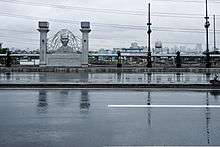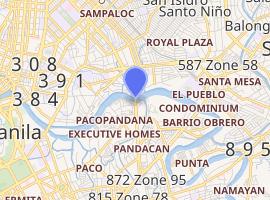Mabini Bridge
Mabini Bridge, formerly and still referred as Nagtahan Bridge, is a road bridge crossing the Pasig River between Nagtahan Street in Santa Mesa and Quirino Avenue in Paco, Manila. It was constructed between January to February in 1945. It initially served as a pontoon bridge transporting U.S. Army jeeps and evacuate citizens caught in the crossfire during the Liberation of Manila.[2]
Mabini Bridge Tulay ng Mabini | |
|---|---|
 | |
| Coordinates | 14°35′45″N 121°00′05″E |
| Carries | 8 lanes of |
| Crosses | Pasig River |
| Locale | Manila |
| Other name(s) | Nagtahan Bridge |
| Named for | Apolinario Mabini |
| Preceded by | Pandacan Bridge |
| Followed by | Ayala Bridge |
| Characteristics | |
| Total length | 160 m (520 ft)[1] |
| Load limit | 20 metric tons (20 long tons; 22 short tons) |
| No. of lanes | 8 (4 per direction) |
| History | |
| Constructed by | US Army Corps of Engineers |
| Construction end | 1945 |

| |
History
There were plans for a new bridge to connect the Mendiola route to Malacañang Palace was made even before the emergence of World War II. However, the construction did not push through.[2] The pontoon bridge stood for several decades after the World War II despite the construction materials used to build it. It was made out of inflated rubber rafts placed side by side - spanning until the opposite bank of the Pasig River. Two parallel perforated steel planks, each measuring about 1 meter (3.3 ft) wide and 1.5 meters (4.9 ft) apart were laid upon its surface. It was built by the US Army Corps of Engineers - enough to carry human traffic as well as light vehicles.[3] In August 17, 1960, a barge collided against the wooden piles of the bridge. It caused major damages to the bridge - which caused flooding within the nearby residences.[2]
In 1963, a permanent bridge was constructed, named Nagtahan. It connected Paco with Pandacan. However, the Mabini Shrine, the former residence of Apolinario Mabini, was situated on the north bank. The government, then, relocated the house at the Polytechnic University of the Philippines in Santa Mesa. In lieu with the 103rd birth anniversary of Apolinario Mabini on July 22, 1967, President Ferdinand Marcos issued the Proclamation No. 234, s. 1967, renaming Nagtahan Bridge as the Mabini Bridge, in memory of Apolinario Mabini, the Sublime Paralytic.[2]
In 2014, the Presidential Communications Development and Strategic Planning Office (PCDSPO) recommended changes, of the existing road signs to read Mabini Bridge, to the Department of Public Works and Highways - as a fitting contribution to the Mabini Sesquicentennial.[2]
Present condition
Of the 13 bridges that crosses Pasig River as of that time, only the Mabini Bridge didn't undergo major face-lifting procedures during 1998. Its huge brass profiles on the sides that illuminates at varying hues were the distinctive features of the Mabini Bridge.[4]
Marker from the National Historical Commission
The marker of Mabini Bridge was installed in July 22, 1967 on the occasion of the 103rd Birthday Anniversary of Apolinario Mabini. It was located along Nagtahan Boulevard - connecting Santa Mesa, Manila and Paco, Manila.[5]
| Filipino inscription | English inscription |
|---|---|
| ANG TULAY NA ITO, DATING NAGTAHAN, AY PINANGALANANG TULAY MABINI NG PANGULONG FERDINAND E. MARCOS NOONG HULYO 22, 1967 NANG IPAGDIWANG AND IKA-103 KAARAWAN NI APOLINARIO MABINI.[5] | THIS BRIDGE, FORMERLY CALLED NAGTAHAN, WAS RENAMED MABINI BRIDGE ON THE OCCASION OF THE 103RD ANNIVERSARY OF APOLINARIO MABINI ON 22 JULY 1967 BY PRESIDENT FERDINAND E. MARCOS.[5] |
See also
References
- "Nagtahan Bridge, City of Manila, Philippines". geoview.info. Retrieved 11 June 2020.
- Legaspi, Mark (21 July 2014). "Briefer: Mabini Bridge and the Mabini Shrine at PUP". Retrieved 24 November 2014.
- Litton, James (2009). Reminiscences of the Battle of Manila: February 3 - March 3, 1945. Battling Bastards of Bataan.
- Ocampo, Ambeth (9 September 2009), "Hidden history of the Pasig River", Philippine Daily Inquirer, archived from the original on 19 December 2014, retrieved 24 November 2014
- Historical Markers: Metropolitan Manila. National Historical Institute. 1993.
| Wikimedia Commons has media related to Mabini Bridge. |